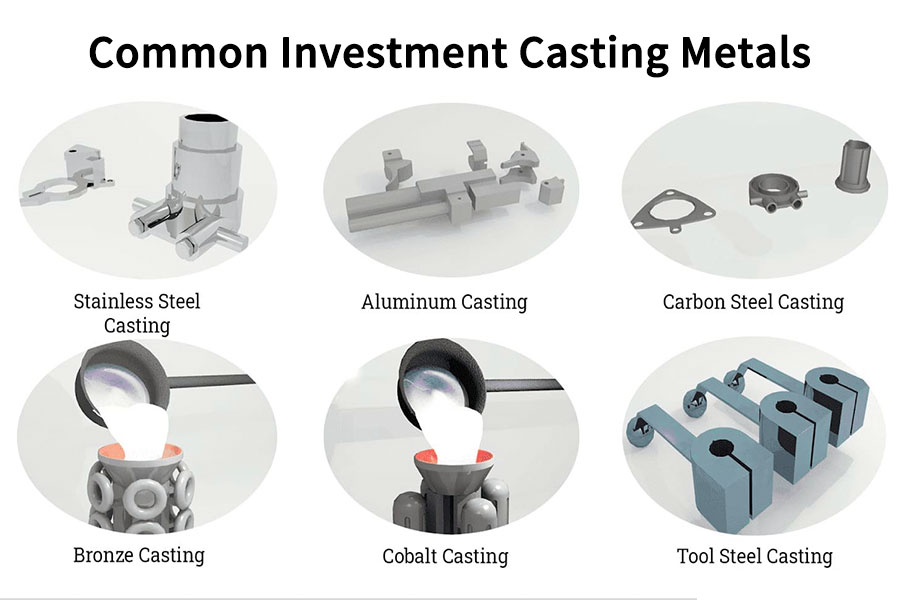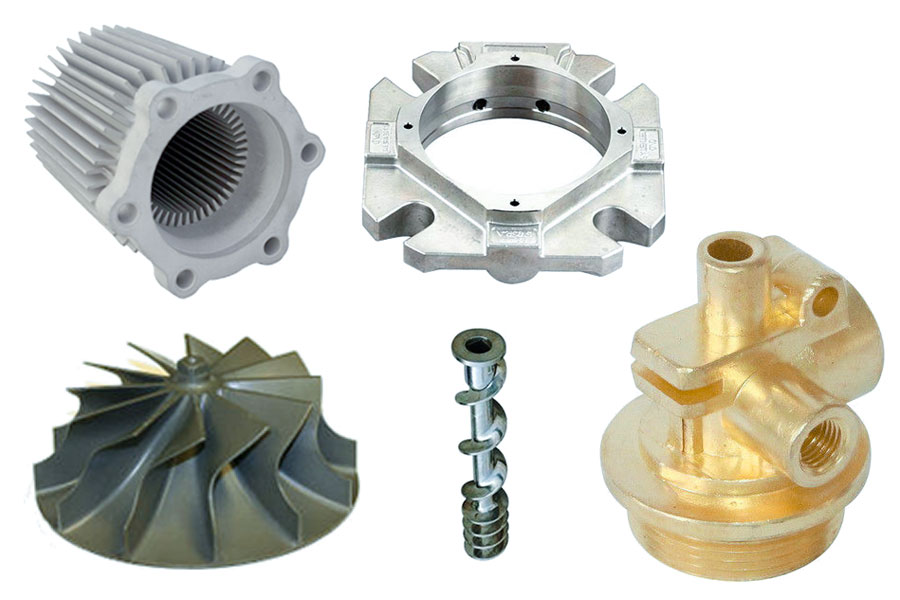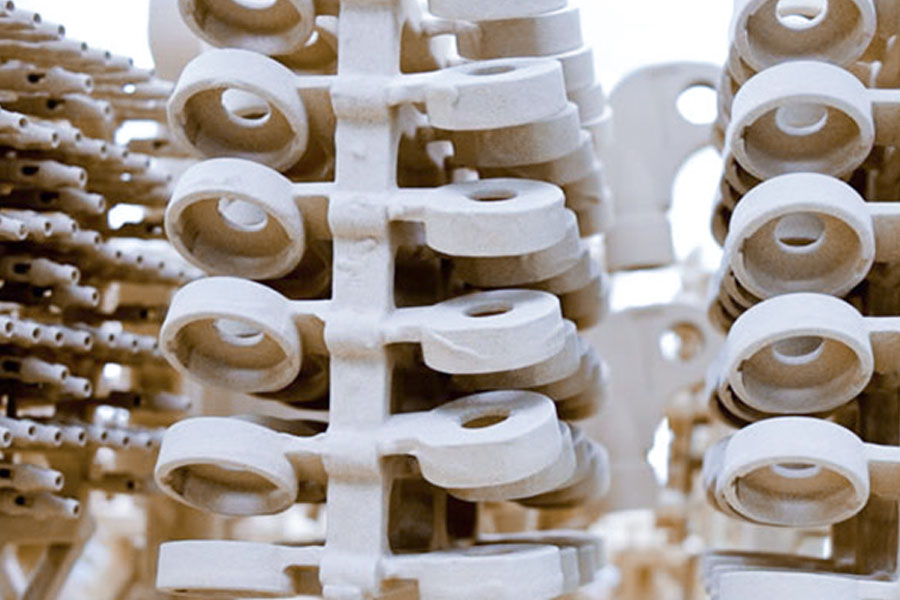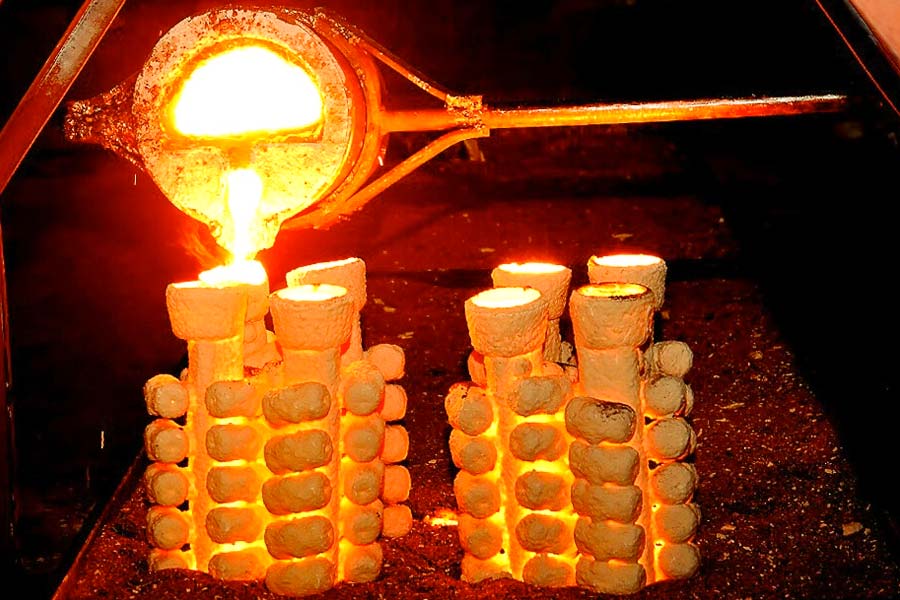Investment casting, also known as lost wax castingIt is a precision metal forming process that is widely used to manufacture parts with complex shapes and high precision requirements. This casting method uses a series of complex processes in which a pattern made of fusible material (investment mold) is encased in a mold shell made of multiple layers of refractory material, the model is then melted and the mold shell is discharged, and finally the molten metal is poured into it. Cool and tangible. SoWhat are the materials used in investment casting?Next, the LS team will take you through an in-depth discussion of the performance characteristics, scope of application, and selection principles of each material, hoping to help readers make a more informed decision on the choice of investment casting materials.
What materials are used in investment casting?
Investment casting mainly uses the following types of materials:
1. Investment Materials
Investment moldingIt is a key component of investment casting and determines the shape and dimensional accuracy of the final casting. Investment mold materials are usually divided into two categories: wax-based mold materials and resin-based mold materials, of which wax-based mold materials are the most commonly used.
Wax-based molding materials: Wax-based molding materials are mainly composed of various wax materials, such as paraffin, microcrystalline wax, Fischer-Tropsch wax, polyethylene wax, etc. These waxy materials have a low melting point and are easy to mold and mold demolded. In addition, you can:Wax-based molding materials, such as polyethylene, ethyl cellulose, etc., to improve its strength and toughness.
2. Resin molding materials
Resin-based molding materials are mainly made of natural resins or synthetic resins, and they have a relatively high melting point. Resin-based molding materials are often used where higher investment quality is required, such as higher dimensional accuracy and surface finish.
3. Refractory materials
The main parts of the mold housing. Commonly used materials include mullite sand, mullite powder, quartz sand, etc. These materials have excellent resistance to high temperatures and chemical stability, and can withstand the high temperatures and pressures of molten metal.
Adhesives: Used to bond refractory particles together to form a strong shell. Commonly used binders include various resins, cement, water glass, etc.
4. Molten metal
thisMade of metalThat is, the final filling in the mold shell can be stainless steel, carbon steel, alloy steel, heat-resistant alloy, copper alloy, aluminum alloy, etc.

What metals are commonly used in investment casting?
Investment casting is a precision casting process that enables the production of metal castings with complex shapes and high precision. In investment casting, the commonly used metal materials are mainly aluminum, stainless steel, titanium, and various alloys. Here is a detailed analysis of these metals:
- Stainless steel:Compared to many other materials,Stainless steel is known for its superior durabilityThis quality has led designers and engineers to increasingly turn to investment casting technology. Stainless steel is used in a wide range of applications, including transmission components and various gears in the automotive industry, as well as camping equipment and golf club heads.
- Low alloy steel:Low alloy steelDue to its affordable price and excellent mechanical properties, it occupies a pivotal position in the machinery manufacturing industry. With a specific heat treatment process, engineers can design different areas of the same workpiece to achieve differentiated properties, for example, making one surface tough and impact-resistant, while the other surface has excellent wear resistance.
- Aluminum alloy:Aluminum alloys are a favorite in the field of investment casting, especially in the aerospace, avionics, electronic equipment and military industries. With the increasing strength of materials and the popularity of high-quality aluminum-silicon-magnesium alloy castings, aluminum alloy castings can now meet the needs of demanding applications such as airframe components.
- Carbon steel:As a low-cost commonly used material,There are various types of carbon steel, which is mainly classified according to carbon content. Through heat treatment, the strength, ductility and overall properties of carbon steel can be significantly improved. The ferromagnetic properties of carbon steel make it suitable for the manufacture of electric motors and appliances. Carbon steel is one of the most commonly used alloys worldwide due to its safety, durability, and excellent structural integrity.
- Super Alloys:Nickel-based and cobalt-based superalloys play an integral role in the aerospace sector, energy, medical, chemical and marine industries. Nickel-based alloys perform well in high-temperature environments, while cobalt-based alloys perform well in corrosion, oxidation, and wear resistance. As superalloys gradually replace sheet metal, they are becoming increasingly popular due to their high stiffness, excellent service characteristics, and cost-effectiveness.
- Copper alloys:Copper-based alloys are known for their excellent corrosion resistance and low wear rates and are widely used in ship propellers, pump propellers, electrical components, and piping components. As a versatile material, copper alloys come in more than 400 different varieties, each with its own characteristics.Investment Casting TechnologyIt can be used to make a variety of copper-based alloy parts, of which bronze and brass are the most common. Beryllium copper is one of the strongest copper alloys, with properties comparable to high-strength alloy steels, and it also has stronger corrosion resistance and longer service life.
- Cast iron:Cast iron, especially gray and ductile iron, is known for its high precision and affordable price. Ductile iron not only has high strength, heat resistance and toughness, but its production process is also relatively complex, resulting in a slightly higher production cost than cast steel.

What non-metallic materials are used in investment casting?
Investment casting technology is a high-precision casting methodIt not only relies on metallic materials, but also requires a variety of non-metallic materials to complete the entire casting process. With the development of modern science and technology and the continuous improvement of product performance requirements, non-metallic materials play a pivotal role in investment casting. Over here:Investment casting process:
1. Waxy substance:
- Application Scenarios:In the investment casting process, wax is mainly used as a base material for building mold patterns. Since wax is made of wax, the wax model is also known as a wax type. Use a press machine or3D printing, we are able to create a wax model that matches the appearance of the desired casting.
- Features:Wax is considered the material of choice for complex moldsDue to its excellent plasticity, ease of processing and suitable melting temperature. Therefore, wax molds are widely used in the casting industry, especially for cavities made of wax for large precision iron castings and thin-walled parts. In addition, the wax's ability to leave no residue throughout the melting process is critical to ensuring the dimensional accuracy and surface quality of the casting.
2. Ceramic Products:
- Use:In the investment casting process,Ceramics are used to make shell molds, also known as a shell. The mold consists of an outer shell of at least one layer of ceramic material. This shell mold provides the high temperature resistance and structural integrity required for molten metal injection and cooling.
- Features:This ceramic material has a high melting point and excellent thermal and chemical stability. This performance allows it to manufacture molds with a variety of complex shapes that are different from many traditional methods. In the investment casting process, the surface of the wax mold is covered with a ceramic slurry and goes through a series of drying and sintering steps to form a stable shell. This ceramic casing is obtained by mixing metal powder with a binder. The enclosure is able to withstand the pouring of hot metal melts and retains its original shape and structural integrity after cooling.

What are the Benefits of Investment Casting?
Investment casting has a number of advantagesInclude:
- High Accuracy:This approach allows for tight tolerances and fine geometries that are often difficult to achieve with other casting techniques. The precision of lost wax casting makes it ideal for components that require high precision and finesse.
- Versatility:Suitable for a wide range of metals and alloys, including ferrous and non-ferrous metals. This versatility allows manufacturers to select the best material for their specific application.
- Smooth surface finish:The process produces parts with excellent surface quality, reducing the need for extensive machining or finishing work. This reduces overall production costs and improves aesthetics.
- Reduced processing:Investment casting minimizes the need for secondary additional work because the part comes out of the mold very close to the final size. This not only saves time, but also reduces material waste.
- Design Flexibility:Lost wax casting enables complex designs that are difficult or impossible to achieve with other casting methods. This flexibility enables engineers to create innovative solutions that meet specific performance requirements.
What are the applications of investment casting?
Investment casting plays a vital role in many industriesDue to its high degree of flexibility and unmatched precision. Here are some examples of particularly prominent application areas:
- Aerospace:Investment casting technology can achieve very high dimensional accuracy and surface finish, and is particularly suitable for the production of castings with complex shapes and high precision requirements.In the aerospace sector, it is widely used in the manufacture of critical components such as engine blades and turbine discs.These parts have extremely high requirements for dimensional accuracy and surface quality, and investment casting technology can meet these needs and ensure the performance and reliability of the parts.
- Automobile manufacturing:In the field of automobile manufacturing,Investment Casting TechnologyIt is used to manufacture parts with complex shapes, such as engine blocks, steering gears, etc. These parts also have high demands on precision and surface quality. Investment casting technology can provide high-quality, high-precision castings, thereby improving the performance and reliability of automobiles.
- Medical Device Manufacturing:In the medical field,Investment casting technology is also used in the manufacture of precision medical devicesand implants. These medical devices and implants have extremely high requirements for dimensional accuracy and surface finish to ensure their safety and effectiveness during use. Investment casting technology can meet these needs and provide high-quality, high-precision castings for medical device manufacturing.

Partnered with LS on investment casting projects
Investment casting is a good metal forming process. It's a tried-and-true method that contributes to lean, high-quality production. Not only is it a cost-effective way to produce custom metal parts and components, but it also allows you to create complex network shapes and complex internal features. Choosing the right investment casting company is very important,
If you are interested in learning more about our investment casting services,Please contact usGet a free quote for your project.
Frequently Asked Questions
1. What types of materials are mainly used in molds?
At its core, investment casting is the use of perishable materials, usually waxy materials, to make molds, known as wax patterns. These wax patterns undergo post-processing, such as coating and baking, to form a molded enclosure where metal can be placed. In addition to waxy materials, natural resins and plastics (synthetic resins) can also be used to make molds, but relatively rarely.
2. What is the coating material of the wax model?
To protect the wax mold and form a sturdy shell after melting, coat the wax mold with several layers of refractory material. These materials typically include a variety of refractory powders, such as ink sands and powders, which are stable at high temperatures to prevent metal melt penetration and support the shape of the casting.
3. What types of alloy castings can be produced by fusion casting mold casting?
Casting mold casting alloy has wide applicability, and can produce alloy castings such as carbon steel, alloy steel, heat-resistant alloy, stainless steel, precision alloy, permanent magnet alloy, bearing alloy, copper alloy, aluminum alloy, aluminum alloy, titanium alloy and ductile iron. These alloys have different mechanical and chemical properties in different application scenarios.
4. What are the commonly used graders for wax molds?
The classifier is used to prevent adhesion between the mold and the wax pattern when pressing the wax mold. For wax-based molds, commonly used typewriters include oil and turpentine, and for resin-based molds, sesame oil and alcohol mixtures or silicone oil are usually used as typewriters. The selection and use of these typewriters is essential to obtain a high-quality wax pattern.
Summary
Investment casting plays an important role in modern manufacturingIt has the characteristics of high precision, complex shape, and wide applicability of materials. With precise control of each process step, investment casting can produce high-quality castings that meet the needs of a variety of complex application scenarios.
Disclaimer
The content on this page is for reference only.LSdoes not make any express or implied representation or warranty as to the accuracy, completeness or validity of the information. No performance parameters, geometric tolerances, specific design features, material quality and type or workmanship should be inferred as to what a third party supplier or manufacturer will deliver through the Longsheng Network. It is the responsibility of the buyerseeking a quote for partsto determine the specific requirements for those parts.Pleasecontact usfor moreinformation.
LS Team
LS is an industry-leading companyFocus on custom manufacturing solutions. With over 20 years of experience serving more than 5,000 customers, we focus on high precisionCNC machining,Sheet metal fabrication,3D printing,Injection molding,metal stamping,and other one-stop manufacturing services.
Our factory is equipped with more than 100 state-of-the-art 5-axis machining centers and is ISO 9001:2015 certified. We provide fast, efficient and high-quality manufacturing solutions to customers in more than 150 countries around the world. Whether it's low-volume production or mass customization, we can meet your needs with the fastest 24-hour delivery. chooseLS TechnologyIt means choosing efficiency, quality, and professionalism.
To learn more, please visit our website:www.lsrpf.com
resource
https://en.wikipedia.org/wiki/Investment_casting







